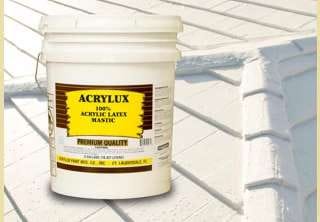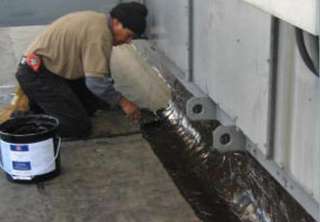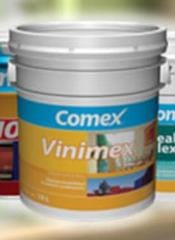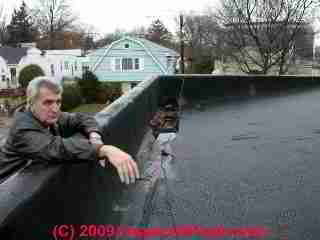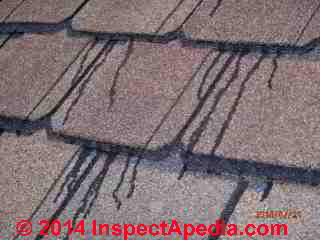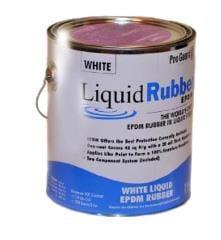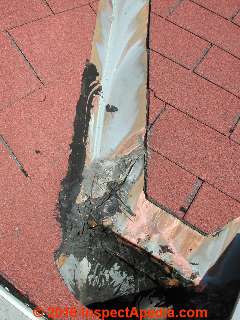 Roof Sealants, Mastics, Coatings
Roof Sealants, Mastics, Coatings
Installing or fixing a leaky roof with roof cements, sealants, coatings
- POST a QUESTION or COMMENT about black run-down stains on asphalt roofing
Advice for choosing & using sealants to repair a leaky or worn roof surface, or to repair roof flashings, valleys, and intersections with other building surfaces.
Roofing sealants have been applied for centuries using just about anything at hand: tar, pine-sap, even sugar to try to seal leaks in a roof that's damaged or at the end of its life. Eking out a few more months or years of roof life an be very tempting but a more legitimate use of sealants is one that is more constrained.
InspectAPedia tolerates no conflicts of interest. We have no relationship with advertisers, products, or services discussed at this website.
Roofing Cements, Sealants, Mastics, Coatings
Roof Patching & Sealant Product Terms, Types, Sources
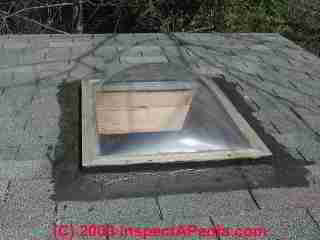 There are two general classes of sealant or coating products used on roofs:
There are two general classes of sealant or coating products used on roofs:
- Roofing mastics: properly, a thick paste applied by trowel, putty knife, or using a caulking gun and used to seal exposed nail or screw heads or small areas of damage, cracks, holes in roofs, as well as along edges of abutting roof materials such as along the top edge of counter-flashing let into a chimney or into a masonry wall.
Some roofing mastics such as the traditional black asphalt roof flashing cement include reinforcing fibers. Mastics are also used as adhesive to glue-down loose shingles and mastics are also widely used as adhesives in other building applications such as flooring. - Roofing sealants: properly, liquid coatings applied by roller or brush onto large areas of a roof surface to seal or extend the the life of a leaky or worn roof surface. Some sealants can be used on many different roof materials such as asphalt shingles, roll roofing, modified bitumen, even tile or slate (though I don't recommend that), while others are compatible only with specific roof coverings, so be sure to read the manufacturer's label as well as the roof sealant instructions from the manufacturer of your roof covering.
Cut-back adhesives or sealants are products that have been thinned using a compatible solvent to produce a thinner coating that may be painted onto a surface and that may penetrate into it.
The skylight repaired with asphalt flashing cement (above) is discussed
at SKYLIGHT LEAK DIAGNOSIS & REPAIR.
[Click to enlarge any image]
There are several types of sealant or coating products used on building roofs by composition. Both mastics and more liquid roof sealants may have similar ingredients.
- Acrylic mastics and sealants, acrylic polymer based products.
- Asphalt-based mastics and sealants use asphalt, a petroleum product, as the primary ingredient, typically fiber reinforced. Asphalt based sealants can be cleaned-up or thinned with paint thinner or mineral spirits. Asphalt based products are also referred to as bituminous or bitumens.
- Emulsified asphalt-based mastics and sealants also use asphalt with the addition of bentonite clay as an emulsifier that reduces flowing and cracking.
- Silicone Roof Sealants, sold in caulking tubes or in gallon cans, are silicone based coatings and sealants that can be applied over many types of building surfaces, providing good adhesion, good UV resistance, and unlike the asphalt and bituminous products silicone sealants do not harden nor shrink with age. Silicone roof products are sold for application by caulk gun, brush, or trowel and in a range of colors: clear, black, white, brown and others.
- Surfactant-treated Roof Coatings add a wetting agent to improve penetration or coating bonding to damp or wet roof surfaces.
- Polyurethane Roof Coatings & sealants including some spray-on products may be used as patching or repair coatings on asphalt roofs.
- Urethane based coatings are used in spray-on roof systems built over urethane foam
Watch out: as you'll see when shopping for roof patching, sealing or coating materials, manufacturers may mix these terms. For example Vinimex®, a widely used liquid roll-on roof sealant is labeled by Comex®, its manufacturer, as a roof mastic.
Watch out: some older roof mastics or sealants contained asbestos as a reinforcing fiber and some may have also included asbestos powder as a filler.
See MASTIC, CUTBACK ADHESIVE, FLASHING CEMENT ASBESTOS for details.
Because builders, contractors, roofers, and vendors use and mix and match so many similar terms for roofing coatings, mastics and sealants we list all of them below along with some illustrations and descriptions of how these products are applied and of their intended use.
Prices for roof sealant/mastic/cement range from less than $10. for a tube of caulk-like sealant to over a thousand for a thick silicone-based roof sealant coating in a 5-gallon container. Don't buy any sealant or roof cement before reading on the product label the roof material types with which it's compatible.
List of Types of Roof Mastics, Sealants, Coatings
- Acrylic roof coatings or sealants are based on the use of polymers that produce hard, flexible coatings that have been incorporated into a waterborne emulsion. Acrylic latex paints are the most-widely used form of these products along with acrylic polymer caulks or sealants. According to National Coatings, a producer of roof coatings, acrylic roof coatings should not be considered as a paint - because of the grater thickness of the coating formed.
Acrylic elastomeric roof coatings refer to a liquid-applied monolithic (seamless), fully adhered, elastomeric membrane that’s formed in situ on the roof. These coatings are applied 5 to 10 times thicker than a house paint. Typically, the thickness of an exterior house paint is 3 mils, .003 inches. For elastomeric roofing applications, these would be 15 to 30 mils. So we’re talking about membrane-like materials. EPDM is often 45 mils; HypalonR and PVC are 60 mils. However, with these coatings the membrane comes out of a can.
That’s why the term formed in-situ on the roof is used. It’s applied as a liquid. As it dries, it forms a tough membrane, like EPDM and like HypalonR. But, unlike those materials, it has no seams. No field or factory seaming is necessary. Moreover it is also fully adhered. These coatings are not mechanically attached like other types of single-ply membranes. - source: National Coatings, "Acrylic Roof Coatings 101", [web page] retrieved 2016/06/12,original source: http://www.nationalcoatings.com/acrylic-roof-coatings-101 - Acrylic roof mastic, typically rolled on to a roof surface in two coats, used on many types of roof surfaces. Below, Acrylux acrylic roof mastic from Acrylux Specialty Coatings, Paints & Sealers, 6010 Powerline Road, Fort Lauderdale FL 33309, USA, Tel: 954-772-0300. Email: info@arylux.com
- Asphaltic grouts - see asphalt mastics
- Asphalt mastics include coatings and trowel-grade flashing cements based on asphalt or coal tar products used for installing flashings, sealing seams, and repairing blisters in asphalt-based roofs such as roll roofing and asphalt shingles. Both hot and cold-application forms of asphalt roofing products are available.
Shown below, Black-Knight® Mastic/Black-Stallion® Mastic polymer-modified coal-tar mastic being used to make repairs on a "coal tar" roofing system. Black-Knight mastic is produced by Garland Company, Inc., 3800 East 91st Street, Cleveland, OH 44105 USA, Tel: 800-321-9336, Website: www.garlandco.com Garland has distributors in the U.S., Canada, and the U.K. U.K. readers can contact garland at www.garlandukltd.co.uk or at +44(0)1452 330646 or at info@garlandukltd.co.uk
- Bituminous dampproofing - for "bituminous" see asphalt products described above.
Cut-back or thinned asphalt coatings are also used as foundation dampproofing agents. In that application the coating does not span nor seal holes, gaps, or cracks. - Cold applied roof cement, in comparison with "hot tar" roofs, cold applied roof cement or coating describes an asphalt or bituminous sealant or cement that can be applied without heating.
- Elastomeric Roof Cement, caulk gun or trowel applied - Elastomeric is a broad term that may be used with acrylic, rubber-based, silicone, urethane and other roof coating and roof cement or mastic products
- Elastomeric Roof Coatings, also referred to as rubber-based coatings or liquid rubber coatings, used on EPDM roofs. Elastomeric roof coatings usually require a two-coat or three-coat process, beginning with a primer, adding a base coat and finishing with a top coat. Also see rubber roof coatings.
- Liquid Applied Roofing - see
GAF UNITED COATINGS LIQUID-APPLIED ROOFING Application & Specifications Manual, [PDF] Source: gaf.com - Plastic roof cement, Plastic roof cement is a trowel-on or caulk-gun applied flashing cement product for residential use using an SBS (Styrene-butadyene-styrene) modified-bituminous roofing sealant. SBS sealants are non-hardening and non-drying, sold as adhesives, sealants, and flashing tapes.
SBS Sealants are produced by several manufacturers including Chemtron. [SBS modified bituminous membrane roofs are a hybrid roofing system combining built-up multiple plies of roofing sheets using styrene-butadyene-styrene (SBS)-modified bituminous membrane roofing. ] Shown below, Roofers Choice brand plastic roof cement in a one-gallon container.
- Polymeric roof sealant - see acrylic roof sealants and coatings
- Roof cement - see roof flashing cement.
- Roof patching compound - generic term for both coatings and trowel-on or caulk-gun applied roof repair products.
- Roof flashing cement is a dense or thick sealant paste applied by trowel or from a tube, used to seal small cracks, holes, gaps, or at intersections of flashing or roofing and other building surfaces.
- Roof sealant, generic term for roof coatings, caulks, compounds. Liquid sealants are intended for brushing or rolling over an area; much more dense sealants are applied by trowel or dispensed from a tube using a caulking gun.
Vinimex® from Comex® [ http://www.comex.com.mx/ ] shown below is a pour or paint on roof sealant described by the company as a roof mastic whose use we illustrate:
See FLAT ROOF LEAK REPAIR for details.
Product description: Impermeabilizante acrílico de alto poder cubriente que forma una capa homogénea capaz de impermeabilizar todo tipo de superficie, aún en superficies verticales. Cuenta con garantía de 3 ó 5 años. Ideal como reflejante en techos y azoteas, lo cual colabora en el ahorro de energía y evita el calentamiento de las viviendas.
- Roofing mastic - see acrylic roof mastics, asphalt roof mastics
- Roof "tar" is typically a more liquid sealant that if improperly applied can make a horrible mess on the roof as you can see in our second photo below. Hot applied tar has been widely used for nearly 100 years as an inter-ply coating in built-up roofing. Below our client is looking at a tar-coated low-slope roof.
See BUILT UP ROOFS for details of that use of roofing tar.
Tar is occasionally mis-applied as an adhesive as we illustrate below.
See ASPHALT SHINGLE TARRY BLEED for details about the messy roof shown above.
- Rubber roof coatings, liquid rubber coatings, EPDM coatings. Liquid rubber roof coatings are also described as liquid EPDM, a one-coat roof coating or sealant. Manufacturers of rubber or liquid EPDM coatings report that liquid rubber coatings may last four times longer than standard acrylic or elastomeric coatings. Sold in 1-gallon & 5-gallon containers in white, black,or gray as well as custom-ordered colors. Shown below, Pro Guard liquid rubber roof coating, Pro Guard Coatings: 1 Industrial Way Denver, PA 17517 (717) 336-7900, website: http://www.proguardcoatings.com/
- Rubber wet patch roof cement (can be applied over damp surfaces)
- Silicone roof coating, a paint-on silicone-based roof coating, typically provided in white, reflective aluminum, or possibly other colors. Shown below, Black Jack Ultra Roof 1000, white siliconized elastomeric roof coating. Black Jack is a Gardner-Gibson product sold at building supply stores.
- Silicone roof sealant (tends to be very durable if the receiving surface is clean and dry enough). General purpose roof patching compound or roofing sealant (clear, white, black, other colors) compatible with most building materials and applicable in both horizontal and vertical locations by caulk gun, trowel, brush. Shown below, Henry Silicone Roof Sealant, Henry Company 999 North Sepulveda Blvd., Suite 800 El Segundo, CA 90245 310-955-9200, E-mail: productsupport@henry.com, Website: us.henry.com
- Wet and Dry Roof Cement - generic term for roof mastics or sealants that include a surfactant to improve coating performance when applied over wet or damp surfaces.
Watch out: Be sure to read the application instructions and roof material compatability remarks provided by the manufacturer of any roof patching compound or sealant you are considering buying. Applying the wrong sealant can actually damage a roof covering if its solvents are not compatible with the roofing material. In particular, some roof coatings or flashing cements are not compatible with asphalt shingles, asphalt roll roofing, EPDM, rubber, or modified bitumen roof coverings.
Life Expectancy of Roof Mastics & Sealants
Despite standards and claims, in our opinion there is no single "right answer" to "how long will this coating, patch or repair last?" I've inspected 20-year old roof coatings in remarkable condition and I've seen coatings and repairs fail from the day after installation. But certainly some materials are more resistant to the wear-forces at work (heat, UV, thermal movement) than others, as we elaborated in the list of coatings and mastics above.
Below we illustrate use of a black asphalt-based flashing cement on a roof surface. Observe how it has aged, dried, shrunk, cracked.
Watch out: as we illustrate in seveal photos throughout this article, applying most sealants across large or long gaps, cracks, or openings without adequate reinforcement by a mesh or fabric is likely to be a short-lived repair.
Heat causes the loss of volatiles from roofing mastics and sealants, causing most products to become more brittle with age. UV radiation also weakens the material and probably oxidizes some of its constituents. Thermal movement caused by changing temperature then pulls-apart and cracks the sealant, as we illustrate above.
How to Use a Reinforcing Fabric When Patching with Roof Cement
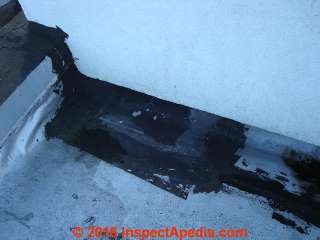 If I were using a roofing mastic to repair a valley I'd pick up a reinforcing mesh sold alongside the mastic in any building supply house; those mesh reinforcers may be fiberglass or synthetic fabric. The mesh gives tensile strength to the repair by being placed down onto the surface and smeared over with mastic sealant. That adds some life to the job.
If I were using a roofing mastic to repair a valley I'd pick up a reinforcing mesh sold alongside the mastic in any building supply house; those mesh reinforcers may be fiberglass or synthetic fabric. The mesh gives tensile strength to the repair by being placed down onto the surface and smeared over with mastic sealant. That adds some life to the job.
Here we illustrate a typical application of roofing cement along the intersection of a roof flashing and wall where leaks had occurred. Over time the combination of drying out of the sealant, thermal changes, and movement cause the sealant to crack and leak again.
Use a patching fabric over projections, larger cracks, gaps, and holes to obtain a longer-lived more durable repair. Using a patching fabric is simple:
- apply a layer of the mastic or patching compound over the problem area
- cut and place a section or strip of patching fabric over the area
- spread an additional layer of roof cement or patching compound over the area
- let the patch cure
I've also re-lined valleys and built-in eaves-trough gutters or yankee gutters with self-adhering ice and water shield products.
Roof Flashing Cement & Sealant Research & Standards
- Asphalt-Based Roof Mastic & Coating Standards
- ASTM D-41, U.S. Standard for asphalt primer coatings
- ASTM D-43, U.S. Standard for coal tar primer coatings
- ASTM D312, U.S. Standard for Types I to IV: for asphalt bitumen primers, coatings, and mastics
- ASTM D450, U.S. Standard for Type I: for coal tar pitch
- ASTM D-2822, U.S. Standard for asphalt-based roof mastic, trowel-grade possibly using asbestos fibers
- ASTM D-2823, U.S. Standard for asphalt roof coatings (solvent type or thinned coatings) using asbestos fibers
- ASTM D-2824 Type I, U.S. Standard for asphalt roof coatings, solvent type, containing aluminum pigment (for reflectivity) - without fiber reinforcement
- ASTM D-2824 Type III, U.S. Standard for asphalt roof coatings, solvent type, containing aluminum pigment (for reflectivity) - with asbestos fiber reinforcement
- ASTM D-2824 Type III, U.S. Standard for asphalt roof coatings, solvent type, containing aluminum pigment (for reflectivity) - with non-asbestos fiber reinforcement
- ASTM D-4022, U.S. Standard for coal tar roof cement that may contain asbestos
- ASTM D-4586 U.S. Standard for asphalt-based roof mastic, trowel-grade, asbestos free but possibly containing other reinforcement fibers
- ASTM D-4479, U.S. Standard for asphalt roof coatings using other types of fibers for reinforcement
- ASTM D-5643, U.S. Sdtandard for coal tar roof cement that is asbestos-free
- Butterfield, W. L., and Fred H. Haney. "Asphaltic Grouts, Mastics, and Cold Applied Cements." In Symposium on Bituminous Waterproofing and Roofing Materials. ASTM International, 1960.
- Cement, E. Plastic. "Flashing grade, fibrated asphalt roofing cement." ASTM D 4586.
- De Buyl, Francois. "Silicone sealants and structural adhesives." International Journal of Adhesion and Adhesives 21, no. 5 (2001): 411-422.
- Lotter, Jason T., Ben Roberts, John L. Henshaw, and Jennifer S. Pierce. "Airborne asbestos exposures associated with the installation and removal of roofing products." Journal of occupational and environmental hygiene just-accepted (2016): 1-35.
- Mastic Asphalt Council, PO Box 77 Hastings TN35 4WL Tel: 01424 814400 Fax: 01424 814446 E-mail: masphaltco@aol.com The MAC, a U.K. association, provides a stunning collection of technical documents concerning the use of asphalt based mastic products. See http://www.masticasphaltcouncil.co.uk/tech-guides/
- Mowat, Fionna, Ryan Weidling, and Patrick Sheehan. "Simulation tests to assess occupational exposure to airborne asbestos from asphalt-based roofing products." Annals of Occupational Hygiene 51, no. 5 (2007): 451-462.
- National Coatings, "Acrylic Roof Coatings 101", [PDF] , National Coatings, 1201 Calle Suerte, Camarillo, CA 93012 USA, Tel: 800-423-9557, Website: www.nationacoatings.com, retrieved 2016/06/12, original source: http://www.nationalcoatings.com/acrylic-roof-coatings-101
- Partanen, Timo, and Paolo Boffetta. "Cancer risk in asphalt workers and roofers: Review and meta‐analysis of epidemiologic studies." American journal of industrial medicine 26, no. 6 (1994): 721-740.
- Paustenbach, Dennis J., Amy Sage, Michael Bono, and Fionna Mowat. "Occupational exposure to airborne asbestos from coatings, mastics, and adhesives." Journal of Exposure Science and Environmental Epidemiology 14, no. 3 (2004): 234-244.
- Quek, Udo, and Jürgen Förster. "Trace metals in roof runoff." Water, Air, and Soil Pollution 68, no. 3-4 (1993): 373-389.
- Shahin, Mohamed Y., David M. Bailey, and Donald E. Brotherson. Membrane and Flashing Condition Indexes for Built-Up Roofs Volume II: Inspection and Distress Manual. Building Research Council. School of Architecture. College of Fine and Applied Arts. University of Illinois at Urbana-Champaign, 1990.
- TILES, CLAY ROOF. "SECTION INCLUDES Roof tiles. Flexible sheet membranes for eave protection, underlayment, and valley protection. Associated metal flashings. Accessories."
- WORMSER, ERIC S., and KENNETH K. KAISER. "Roof Coatings." Paint Handbook (1981): 1.
- Wypych, George. Handbook of material weathering. 2003.
Using Roof Sealant to Repair a Leay Roof Valley
Reader Question: repairing a roof valley with roofing sealant vs. other approaches
2016/06/10 Rebecca said:
My recently purchased 1960's house with a two-layer asphalt roof has a leaking valley. The rest of the roof seems sound (excepting need for gutters, etc.). I want to repair this myself (and a roof tear-off is simply not a financial option right now). What challenges might I face beyond replacing the roof roll and the puzzle-like replacement of two layers of shingles?
This question appeared originally at DRIP EDGE FLASHING for ROOFS
Shown below: hanging plastic bags in the attic (or putting buckets under leaks) makes sense as an emergency stop-gap way to face some roof leaks but it's hardly a reasonable nor effective repair.
[Click to enlarge any image]
Reply:
Sorry I don't fully understand the situation;
 Watch out: From what I think is the case, you face these risks, in order of importance:
Watch out: From what I think is the case, you face these risks, in order of importance:
1. falling off the roof and being injured or killed
2. causing more damage to the roof when you walk on it, increasing the size of the repair job
3. finding it difficult to cut nails and lift shingles on the older roof sufficiently to place down a new layer of valley liner.
If the roof is in the last 1/4 of its life I'd prefer to stay off of it as much as possible: brittle shingles easily damaged by foot traffic; I might try working with care on padded surfaces to patch or seal the valley - a "band-aid" temporary repair that you can make more durable if you combine a fabric with your roof mastic to seal the valley.
Our photo shows black asphalt roof cement patching coating in a leaky roof valley on a clay tile roof in New York. That roof is discussed at CLAY TILE ROOF FLASHING LEAKS
Reader follow-up: what tools do I need?
Rebecca said:
Point number 3 is more along the lines I meant--sorry to leave you a vague question. We had a cricket added to the chimney, due to leaking there caused mostly by tar repairs causing dams, and general neglect.
It appears tar dams are the primary culprit for leaking along this valley, as well. I plan to inspect the roof deck from inside the attic to determine the extent of the roof deck damage.
I do plan to use rope/safety gear when on the roof for this extended period of time.
What tools should I have ready to remove the shingles and nails?
Moderator reply:
I generally do not recommend roof repairs by someone with no experience, no training, and no one with experience to help them, because of the risks involved.
A problem is that you don't know what you don't know - you don't even know that you're missing something; the result is possibly an unnecessarily costly and ineffective or short lived repair. While small repairs such as sealing a little hole or leak in a roof are within the grasp of many homeowners who are otherwise able to tackle the dangers of fooling around on a roof, even then I'd at least read some roofing instruction guides or get help from someone with experience and training.
Also see FLASHING, ASPHALT SHINGLE VALLEYS
Asphalt shingle roofs use normal carpentry & roofing tools including a few flat bars; when pulling up a lot of shingles roofers use a stripping tool but typically one can get by with a short-handled flat-bladed shovel; the added width of the blade can reduce un-wanted shingle damage. Occasionally I'll use a slater's nail cutting tool - that's a long flat bar with notches - the tool can be driven up under shingles and then hammered down to cut nails. You shouldn't need that for repairing a valley.
For applying roof mastic I use a small mason's trowel and of course disposable clean-up solvent & towels. Often having a pair of trowels or a trowel and a putty knife allow me to scrape mastic off of one blade onto another for more careful and detailed work. Be careful how you dispose of that trash: leaving it in a hot trash can can start a fire.
Keep in mind however that if you only seal the open surface of the valley water may back up under the shingles that abut the valley and might still leak, particularly if the valley doesn't drain rapidly off of the roof.
All of this to me sounds as if patching valleys by coating is the cheapest, quickest job that's also short-lived and a bit ugly.
But doing a proper valley-liner replacement requires lifting shingles along the valley; on an old roof you'll find the shingles fragile.
Reader follow-up: what's roofing mastic?
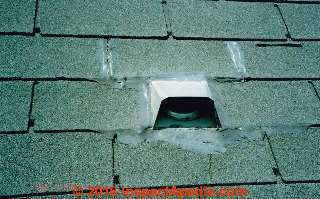 Rebecca said:
Rebecca said:
And would you please expand your roof mastic comment--my research so far on repairing the valley has not included roof mastic. Thank you so much!
Photo: roof sealant used around a dryer vent installed through a roof surface.
[Click to enlarge any image] Take a closer loo9k to see how this sealant has dried and cracked.
Moderator reply:
Rebecca:
Roofing mastic aka roof flashing cement is a thick tarry sealant, typically sold in gallon or larger sized containers or more expensively in caulk/sealant tubes for very small jobs. I'd consider coating with a high quality rubber roof sealant unless the damage in the valley is severe.
The roof cement is traditionally an asphalt-based product with reinforcing fibers.
There are other substitute roof leak sealing coatings including thick paints.
All roofing mastics will in my experience ultimately fail by drying out and cracking, though there are some rubber roof coating products that claim they're immune from that problem.
The copper roof valley shown above cracked and leaked from thermal movement; you can see that repairs were attempted using a black asphalt-based flashing cement. Unfortunately not only did the flashing cement give only short term relief, its chemistry attached the copper below, thinning and corroding the copper. Below is another example of roof flashing cement failure on the same roof.
Reader Comments, Questions & Answers About The Article Above
Below you will find questions and answers previously posted on this page at its page bottom reader comment box.
Reader Q&A - also see RECOMMENDED ARTICLES & FAQs
On 2020-10-01 - by (mod) -
Rob when I'm faced with having to make what can be at best a temporary repair on a fragile asphalt shingle roof
1. I consider that going on to the roof at all may cause more damage; If I must work on it I work from a latter padded off of the roof surface and perhaps hung from the ridge.
2. If I can very gently free shingles above the damage area but I can not insert new shingles then I slip up flashing under the upper shingle course and seal below with mastic or nail it down and seal the nail top with silicone;
3. There are spray on and paint-on roof repair coatings including rubber sprays that may also give temporary life extension.
On 2020-10-01 by Rob
My shed has a few damaged shingles, I was going to replace only those shingles but they're so old and fragile they will just break. I can't afford to re-roof the whole shed. They are asphalt 3 tab shingles. What would be my best option to extend the life a few years (hopefully 3-5 years), maybe a product like Henry Roof Saver or Comex Vinimex?
On 2020-09-18 - by (mod) -
Thanks Jim; we work hard on this information so are very grateful when readers find it useful. We also welcome your questions, content suggestions, or criticism.
Daniel
On 2020-09-18 by Jim
Very informative website, thank you!
On 2020-03-25 by Marc
Thanks a lot for the input Dan !!!
On 2020-03-24 - by (mod) -
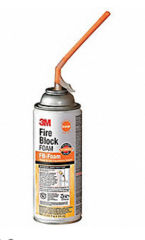 I agree, Marc and I apologize for not being clear.
I agree, Marc and I apologize for not being clear.
If I had a foam-insulated roof with a small area of damage I'd simply buy an open or closed-cell foam (hoping to match the original foam type), fill the damage area, the shave off the excess, then repair the roof.
A simple small spray can of suitable foam ought to be fine. I've used closed-cell fire-foam in some cases.
I've done that at PLUMBING VENT REPAIR (though the foam isn't much visible)
and
at PLASTIC ELECTRICAL BOX REPAIR where we were replacing a plastic electrical box in a foam-insulated cathedral ceiling roof.
The 3M FireBlock spray foam shown here costs about $15. U.S. and requires no special equipment nor fancy roof foam spraying apparatus.
On 2020-03-23 by Marc
there has to be a way to patch a foam crack of a few inches without using actual SPF sprayed with a complex kit :(
Henry's "885 Tropi-Cool 100% Silicone Seam and Repair Roof Sealant" is said to be compatible with SPF according to the instruction ... but i don't know how accurate that is :-/
On 2020-03-23 by Anonymous
Marc
I think the foam kit needs depend on the amoubt if repair needed
On 2020-03-22 by Marc
i hoped i did not have to buy such kits but i guess it makes sense to stay with polyurethane foam to replace polyurethane foam
On 2020-03-22 by Marc
Thank you Dan. So i should get an actual roof foam spray kit and not just patch the foam it with a simple wet patch ... ok.
On 2020-03-20 - by (mod) -
I would fill voids with a compatible spray foam, let it cure, slice it flush, and repair the roof.
On 2020-03-20 by Marc
My foam roof has blisters - once i cleaned the elastomeric and maybe got rid of some damaged foam - how can i patch the hole in the foam, which product can i use ? (before adding elastomeric coating on top) ?
On 2019-02-27 by (mod) -
PM
I'm sorry but I don't know what's going on in the photo that you attached. It almost looks as if someone sprayed open or closed so insulating foam along a metal roof ridge vent. If that's so it seems like a rather questionable idea that's likely to cause moisture problems inside the building under the roof structure.
On 2019-02-27 by Pretty Mhlongo
Could u please help me out with the name of the product used to seal this roof as my own roof is like this one & I would like to seal it for dust particles & wind....thank you
On 2018-12-12 by (mod) -
Most likely you need a structural connection of the posts to the structure below + flashing and sealant; just sitting a post on a pad invites a catastrophe at the next windstorm.
On 2018-12-10 by Mark
Pergola posts on a flagstone roof top patio, over a living space
On 2018-06-30 by (mod) -
Mark:
If you are discussing human allergies (to something) I'm unclear how or why any roof sealant on asphalt shingles would be helpful at all.
On 2018-06-30 by Mark Sanders
I’m only looking to buy House Roof Sealent over Ashfall shingles they say keeps allergy from coming back ! So I’m doing my homework to see if it works ?
...
Continue reading at ASPHALT SHINGLE TARRY BLEED or select a topic from the closely-related articles below, or see the complete ARTICLE INDEX.
Or see these
Recommended Articles
- ASPHALT SHINGLE BLISTER RASH CAUSE
- FLASHING on BUILDINGS
- FLASHING, ASPHALT SHINGLE VALLEYS
- MASTIC, CUTBACK ADHESIVE, FLASHING CEMENT ASBESTOS
- ROOF LEAK DIAGNOSIS & REPAIR - home
- SEALANTS CAULKS COATINGS for LOG HOMES
Suggested citation for this web page
ROOF SEALANTS & MASTICS at InspectApedia.com - online encyclopedia of building & environmental inspection, testing, diagnosis, repair, & problem prevention advice.
Or see this
INDEX to RELATED ARTICLES: ARTICLE INDEX to BUILDING ROOFING
Or use the SEARCH BOX found below to Ask a Question or Search InspectApedia
Ask a Question or Search InspectApedia
Try the search box just below, or if you prefer, post a question or comment in the Comments box below and we will respond promptly.
Search the InspectApedia website
Note: appearance of your Comment below may be delayed: if your comment contains an image, photograph, web link, or text that looks to the software as if it might be a web link, your posting will appear after it has been approved by a moderator. Apologies for the delay.
Only one image can be added per comment but you can post as many comments, and therefore images, as you like.
You will not receive a notification when a response to your question has been posted.
Please bookmark this page to make it easy for you to check back for our response.
Our Comment Box is provided by Countable Web Productions countable.ca
Citations & References
In addition to any citations in the article above, a full list is available on request.
- Akbari, Hashem, P. Berdahl, R. Levinson, R. Wiel, A. Desjarlais, W. Miller, N. Jenkins, A. Rosenfeld, and C. Scruton. "Cool colored materials for roofs." In Proceedings of the ACEEE 2004 Summer Study on Energy Efficiency in Buildings, vol. 1, pp. 1-12. 2004.
- ASTM D3161-81 Standard Test Method of Wind Resistance for Asphalt Shingles. Orignially published 1972.
- Berdahl, Paul, Hashem Akbari, Ronnen Levinson, and William A. Miller. "Weathering of roofing materials–an overview." Construction and Building Materials 22, no. 4 (2008): 423-433. Abstract
An overview of several aspects of the weathering of roofing materials is presented. Degradation of materials initiated by ultraviolet radiation is discussed for plastics used in roofing, as well as wood and asphalt. Elevated temperatures accelerate many deleterious chemical reactions and hasten diffusion of material components. Effects of moisture include decay of wood, acceleration of corrosion of metals, staining of clay, and freeze–thaw damage. Soiling of roofing materials causes objectionable stains and reduces the solar reflectance of reflective materials. (Soiling of non-reflective materials can also increase solar reflectance.) Soiling can be attributed to biological growth (e.g., cyanobacteria, fungi, algae), deposits of organic and mineral particles, and to the accumulation of fly ash, hydrocarbons and soot from combustion. - Bennert, Thomas, Ali Maher, and Robert Sauber. "Influence of production temperature and aggregate moisture content on the initial performance of warm-mix asphalt." Transportation Research Record: Journal of the Transportation Research Board 2208, no. 1 (2011): 97-107.
- "CertainTeed GrandManor™ Luxury Shingles", CertainTeed Corporation, (2014) product brochure. CertainTeed Corporation, Saint-Globain, Tel: 800-233-8990, Website: certainteed.com Retrieved 2/23/2014, original source: https://www.certainteed.com/resources/GrandManorBroch.pdf. This brochure describes fiber glass based shingles with randomly applied tabs, "virtual five layer coverage" when applied, 425 lbs. per square. Among the product specifications are wind resistance, UL certified to meet ASTM D3018 Type 1 and ASTM D3131, lass F, 110 mph wind resistanc.
- "Technical Data Sheet, Grand Manor® Shingles", Sweets Construction, retrieved 7/23/14, original source: https://sweets.construction.com/swts_content_files/28175/523953.pdf, Quoting:
CertainTeed GrandManor™ shingle warranty:
Grand Manor carries a lifetime limited transferable warr anty against manufacturing defects for the original homeowner. In addition, Grand Manor also carries 10-year SureStart™ Protection. For specific warranty details and limitations, refer to the warranty itself (available from the local supplier, roofing contractor or on-line at www.certainteed.com ) - Corbett, Luke W., and Rolf Urban. "Asphalt and bitumen." Ullmann's Encyclopedia of Industrial Chemistry (1985).
- Cullen, WILLIAM C. "Research and performance experience of asphalt Shingles." In 10th Conference on Roofing Technology, vol. 7. 1993. [Cullen writes under the aegis of the NRCA - Ed.]
- Falchetto, Augusto Cannone, Mihai O. Marasteanu, and Herve Di Benedetto. "Analogical based approach to forward and inverse problems for asphalt materials characterization at low temperatures." Journal of the Association of Asphalt Paving Technologists 80 (2011).
- Hanz, Andrew, Enad Mahmoud, and Hussain Bahia. "Impacts of WMA production temperatures on binder aging and mixture flow number." Journal of the Association of Asphalt Paving Technologists 80 (2011). Abstract:
Due to the potential to realize environmental benefits related to lower production temperatures, implementation of Warm Mix Asphalt (WMA) has generated interest at state and national levels. However, from the standpoint of sustainability, WMA must meet or exceed the performance of conventional HMA. Consequently, successful implementation requires mix design procedures that consider the impacts of reduced production temperatures on material properties and the overall performance of the mixture. In this study the effects of reduced aging temperatures were evaluated through characterization of asphalt binder properties after short-term aging at standard and lowered RTFO temperatures and long-term aging under standard PAV conditions. Materials tested included two asphalt binder sources and three WMA additive types. It was found that reduced aging temperatures have a significant influence on the high temperature performance of binders, but a negligible effect on intermediate and low temperature rheological properties evaluated after PAV aging. Results were modeled based on the procedures provided in NCHRP 9- 43 to define the maximum allowable reductions in production temperature for the materials tested in this study. Preliminary findings indicate that the predicted temperature reductions for the FHWA aging model and the laboratory generated data set differed by 9 C, indicating that refinement of the model through evaluation of additional binder sources, grades, and WMA additives is needed. In addition, the need for establishing minimum production temperatures for WMA to ensure adequate field performance is emphasized, due to the observation of similar sensitivity to aging temperature in mixture performance testing. - Halunen, Clayton, Quoting: Posted by
Clayton Halunen
(halunen@halunenlaw.com) on
Wed, Nov 9, 05 at 11:58
My law firm is currently investigating CertainTeed shingles based upon complaints of deterioration and curling we have received throughout the country. We will seek to have CertainTeed reimburse customers for the cost of replacing their roofs. If you have CertainTeed shingles that have failed, please contact me at (612) 605-4098 or: halunen@halunenlaw.com. - retrieved 2/23/14, original source: http://ths.gardenweb.com/forums/load/repair/msg0821243518283.html
[Contacted with request for product failure details 7/23/14] - Inchem, "Asphalt, Bitumen, Petroleum Bitumen" properties, CAS# 8052-42-4, UN# 1999", retrieved 7/22/2014, original source http://www.inchem.org/documents/icsc/icsc/eics0612.htm
- IKO Production, Inc., "MSDS #1810 - Granular Bituminous Shingle Material", IKO Production, Inc., 120 Hay Road, Wilmington DE 19809, USA, retrieved 7/22/14, original source: http://www.canroof.com/publication/ 1810-msds-granular-bituminous-shingle-material/wppa_open/
- Jones, David S.J., and Peter P.Pujado (Editors) (2006). Handbook of Petroleum Processing, First Edition. Springer. ISBN 1-4020-2819-9.
- Newcomb, David E., Mary Stroup-Gardiner, Brian M. Weikle, and Andrew Drescher. "Properties of dense-graded and stone-mastic asphalt mixtures containing roofing shingles." ASTM SPECIAL TECHNICAL PUBLICATION 1193 (1993): 145-145.
- Noone, MICHAEL J., and W. KENT Blanchard. "Asphalt Shingles–A Century of Success and Improvement." In Proceedings of the 10th Conference on Roofing Technology, pp. 23-33. 1993.
- Parker, Danny S., and John R. Sherwin. "Comparative summer attic thermal performance of six roof constructions." TRANSACTIONS-AMERICAN SOCIETY OF HEATING REFRIGERATING AND AIR CONDITIONING ENGINEERS 104 (1998): 1084-1092.
- Shaw, DONALD E. "ARMA’s New Approach for Evaluation of Asphalt Shingle Wind Resistance." In Proceedings of the Third International Symposium on Roofing Technology, p. 216. 1991.
- TAMKO Shingle Products, Material Safety Data Sheet (MSDS) -T01A2011, Tamko Shingle Products, TAMKO Building Products, Inc., PO Box 1404, Joplin MO 64802, Tel: 1-417-624-6644, retrieved 7/22/2014, original source http://www.tamko.com/docs/documents-msds/ TAMKO%C2%AE_Asphalt_Shingle_MSDS.pdf?sfvrsn=0
- Terrenzio, LOUIS A., JOHN W. Harrison, DAVTO A. Nester, and M. L. Shiao. "Natural v. artificial aging: use of diffusion theory to model asphalt and fiberglass-reinforced shingle performance." In Proceedings of the Fourth International Symposium on Roofing Technology. 1997.
- U.S. EPA, "Asphalt Category Analysis and Hazard Characterization", Submitted to the US EPA by the American Petroleum Institute Petroleum HPV Testing Group (July 2009), retrieved 7/22/14, original source: http://www.epa.gov/hpv/pubs/summaries/asphlcat/c14901ad2.pdf
- http://birdstairs.ca/files/Guide%20to%20Ashphalt%20Roofing%20Shingles%20and%20Installers.pdf
- http://www.gaf.com/Commercial_Roofing_Systems/GAFGLAS/GAF_GAFGLAS_RUBEROID_ Application_and_Specification_Manual_without_CAD_Details_315_pages_2MB.pdf
- "The Effect of Radiant Barriers in an Attic Application on Exterior Roofing Materials, Technical Bulletin 103", Reflective Insulation Manufacturers Association International (RIMA-I)
PO Box 4110
Olathe, KS 66063
Toll-Free: (800) 279-4123
Phone/Fax: (913) 730-8869, Retrieved 7/22/2014, original source http://www.rimainternational.org/index.php/technical/tb-index/tb103/
Excerpted Quote:- The effect of attic radiant barriers on the temperatures of roofing materials is the subject of a recently completed RIMA-I study. Dark roofing material (shingles) can absorb as much as 95% of incident solar radiation and, as a result, will increase in temperature above the surrounding air temperature. The temperature reached by a roof in the heat of the day depends partly on the amount of heat transferred downward into the attic and conditioned space. The installation of an attic radiant barrier significantly decreases the amount of heat transferred in the downward direction with the result that the roof material temperatures will increase. The questions addressed by this bulletin are the magnitude of the temperature increase and the effect of the temperature increase on material warranties. The results of this study are:
- Roof shingle temperature increases due to attic radiant barriers are 2 to 5 degrees Fahrenheit.
- Roofing material warranties are not affected by the installation of attic radiant barriers.
- ASTM C 1313-00 Standard Specification for Sheet Radiant Barriers for Building Construction
Applications - ASTM C 1158-01 Standard Practice for use and Installation of Radiant Barrier Systems (RBS)
in Building Construction - Jim Todd, provided photographs and description of shingle blister rash on a four year old Atlas Chalet™ shingle roof. 9 July 2009.
- Low Slope Roofing, Manual of, 4th Ed., C.W. Griffin, Richard Fricklas,
McGraw-Hill Professional; 4 edition, 2006, ISBN-10: 007145828X, ISBN-13: 978-0071458283
- Roof failure causes in depth (and specific methods for avoiding them)
- Roof design fundamentals and flourishes, based on voluminous industry research and experience
- New technologies and materials -- using them safely and correctly
- Comprehensive coverage of all major roofing systems pecifications, inspection, and maintenance tools for roofing work
- Problems in Roofing Design, B. Harrison McCampbell, Butterworth Heineman, 1991 ISBN 0-7506-9162-X (available used)
- Asphalt Roofing Residential Manual from ARMA the Asphalt Roofing Manufacturers Association Website https://www.asphaltroofing.org/product/residential-asphalt-roofing-manual/ ,
- Building Pathology, Deterioration, Diagnostics, and Intervention, Samuel Y. Harris, P.E., AIA, Esq., ISBN 0-471-33172-4, John Wiley & Sons, 2001 [General building science-DF] ISBN-10: 0471331724 ISBN-13: 978-0471331728
- Building Pathology: Principles and Practice, David Watt, Wiley-Blackwell; 2 edition (March 7, 2008) ISBN-10: 1405161035 ISBN-13: 978-1405161039
- Our recommended books about building & mechanical systems design, inspection, problem diagnosis, and repair, and about indoor environment and IAQ testing, diagnosis, and cleanup are at the InspectAPedia Bookstore. Also see our Book Reviews - InspectAPedia.
- In addition to citations & references found in this article, see the research citations given at the end of the related articles found at our suggested
CONTINUE READING or RECOMMENDED ARTICLES.
- Carson, Dunlop & Associates Ltd., 120 Carlton Street Suite 407, Toronto ON M5A 4K2. Tel: (416) 964-9415 1-800-268-7070 Email: info@carsondunlop.com. Alan Carson is a past president of ASHI, the American Society of Home Inspectors.
Thanks to Alan Carson and Bob Dunlop, for permission for InspectAPedia to use text excerpts from The HOME REFERENCE BOOK - the Encyclopedia of Homes and to use illustrations from The ILLUSTRATED HOME .
Carson Dunlop Associates provides extensive home inspection education and report writing material. In gratitude we provide links to tsome Carson Dunlop Associates products and services.


